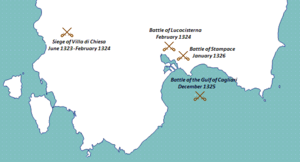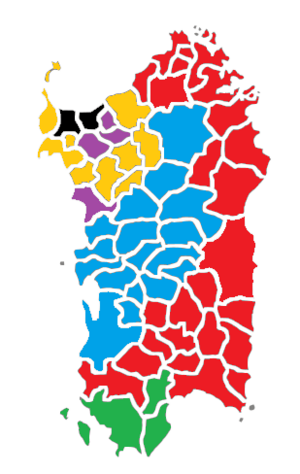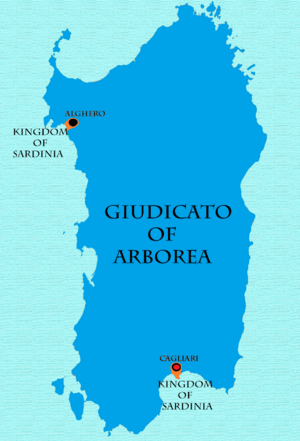Aragonese conquest of Sardinia facts for kids
Quick facts for kids Conquest of Sardinia |
|||||||
|---|---|---|---|---|---|---|---|
 Major battles of the campaign |
|||||||
|
|||||||
| Belligerents | |||||||
|
|
|||||||
| Commanders and leaders | |||||||
| Strength | |||||||
| unknown | unknown | ||||||
The Aragonese conquest of Sardinia was a series of battles and events that happened between 1323 and 1326. During this time, the Crown of Aragon took control of the island of Sardinia.
Before the conquest, Sardinia was influenced by different groups. These included the Republic of Pisa, the Pisan della Gherardesca family, Genoa, and the Genoese families of Doria and Malaspina. The only local power that remained was the Judicate of Arborea, which was an ally of Aragon.
James II of Aragon had been given Sardinia by Pope Boniface VIII in 1297. However, he waited a long time to conquer it. This was because Aragon had financial problems from wars in Sicily and conflicts with the Crown of Castile.
Sardinia was very important to Aragon. The island had valuable natural resources like silver and salt. It also had a good economy based on farming and raising animals. Its location was key for controlling the western Mediterranean Sea. Sardinia was also a perfect stop for a new "island route" that could cut travel time to rich markets in the Eastern Mediterranean.
Key Events

- In 1321, the Cortes (a kind of parliament) of Girona agreed to help. They got support from the Kingdom of Valencia and the Kingdom of Aragon.
- On April 11, 1323, Hugh II of Arborea became a loyal supporter of James II. In return, he kept his family's rights over his land. Hugh II then started fighting the Pisans and defeated them near Villanovaforru and Sanluri.
- On May 15, 1323, a small fleet left Barcelona to help the Arborean leader. They took a position near Quartu Sant'Elena, close to the Pisan city of Castel di Castro (now Cagliari).
- On May 31, a large fleet of 300 ships left Port Fàngos. It included many types of ships, like cogs (large merchant ships) and galleys (warships). The fleet stopped in Menorca before sailing to Sardinia.
- On June 13, the Aragonese fleet landed at Palmas in Sulcis. This created their first base on the island.
- On June 28, the Aragonese army, led by Infant Alfonso, began to attack Villa di Chiesa (now Iglesias). This was an important mining town controlled by Pisa.
- In October, a Pisan fleet attacked two Catalan ships but then left.
- On February 7, 1324, Villa di Chiesa surrendered after being under attack for seven months. The people inside were starving.
- On February 13, the Aragonese reached Castel di Castro. Pisa sent a fleet of 40 galleys and other ships to help their army trapped in the city.
- On February 25, the Aragonese ships tried to fight the Pisan fleet near Castel di Cagliari. The Pisans avoided the fight. After talking, the Aragonese allowed the Pisan fleet to land safely near Capoterra.
- On February 29, the Aragonese and Pisan armies fought a big battle near Elmas. This Battle of Lucocisterna was a tough fight, but the Aragonese won. On the same day, the Pisan fleet was defeated in the waters near Cagliari.
- After losing the battle, the Pisans had to give up their lands in Sardinia to the Aragonese. These lands included the former Judicates of Calari and Gallura. Pisa kept control of Castel di Castro and its nearby villages for a short time.
- In September, the Doria family in Sardinia tried to take Sassari. Sassari had been allied with Genoa but joined the Aragonese in 1323. Pisa, now allied with Genoa, declared war on Aragon again.
- In November, a Pisan-Genoese fleet gathered in Savona and then sailed to Sardinia.
- On December 29, the Aragonese fleet was defeated in a naval battle in the Gulf of Cagliari by the Pisan-Genoese fleet.
- In January 1325, the Aragonese army attacked Stampace, a village near Castel di Castro. Pisa was forced to surrender completely. Castel di Castro became part of the new Kingdom of Sardinia in June 1326 and was made its capital.
What Happened Next
Even after the conquest, there were more conflicts. In 1347, Aragon and the Doria family, who controlled much of northern Sardinia, fought again.
The Judicate of Arborea, led by Marianus IV of Arborea, worried that Aragon wanted to control the whole island. So, Arborea broke its alliance with Aragon and, along with the Doria family, declared war. In 1368, Arborea almost pushed the Aragonese off the island. The "Kingdom of Sardinia" was reduced to just the port cities of Cagliari and Alghero.
A peace treaty in 1388 gave Aragon back its lands. But problems continued. In 1391, the Arborean army, led by Brancaleone Doria, took control of most of the island again. This situation lasted until 1409, when the Arborean army was badly defeated by the Aragonese in the Battle of Sanluri.
In 1420, the remaining Arborean territories were sold to the Judicate of Arborea for a large sum of money. This meant the "Kingdom of Sardinia" finally controlled almost the entire island. The only exception was the city of Castelsardo, which was taken from the Doria family in 1448. Since Aragon never managed to take Corsica from the Genoese, Corsica was removed from the official name of the Kingdom.
|
See also
 In Spanish: Conquista aragonesa de Cerdeña para niños
In Spanish: Conquista aragonesa de Cerdeña para niños




